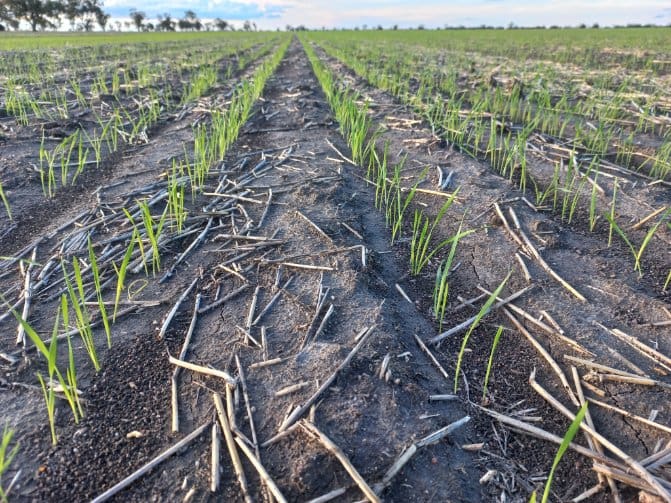
Wheat crops like this paddock of Lancer near Moree are off to a fine start following recent rain which has made accessing on-farm grain difficult in some areas.
PRICES for wheat and barley into the domestic stockfeed market have firmed by around $5 per tonne in the past week as rain in northern regions and dry conditions in the south quash grower interest in selling into nearby positions.
Trucks remain hard or impossible to book for longer legs, and growers are either flat out planting their crops, or are on standby as they wait for rain to wet topsoil and get them started or restarted in their sowing programs.
Larger consumers are seen as having some coverage out to August-September, but smaller mills are battling to book tonnes and trucks as the export task continues to preoccupy the market.
| Nearby | New-crop January | |
| Barley Downs | $297 up $7 | $285 steady |
| Wheat Downs | $325 up $5 | $330 up $10 |
| Sorghum Downs | $320 up $5 | NQ |
| Barley Melbourne | $275 steady | $265 down $10 |
| Wheat Melbourne | $340 steady | $330 down $10 |
Table 1: Indicative delivered prices in Australian dollars per tonne.
Gaps to fill
In the southern market, GeoCommodities broker Brad Knight said spot markets were trading at a sizeable premium to deferred ones as logistics continues to limit supplies to smaller domestic consumers.
“We’ve probably ratcheted up another $5 a tonne at least, and $10 or more in places since last week,” Mr Knight said.
Planting is keeping some farmer trucks off the road, and their absence is being felt as transport companies largely feed the export beast.
“Exporters and others are short logistics.”
The ongoing shortage of trucks available to bring grain from farm to port or metropolitan consumer is squeezing traders and millers.
“The bigger ones have grain ahead of them, but it’s challenging to get orders honoured this month.
“They can afford to miss a few loads coming in, but when they miss a few more, that’s when they get problems.”
“Those that have got time to deliver are not selling as much because the weather’s dried up.”
“The next 10-14 days will be telling.
“A lot of Vic and SA mightn’t germinate until we get into June, and then you can start to put some question marks against yields.”
In new-crop markets for wheat and barley, activity has been limited in the trade and almost non-existent from the grower.
Mills supplying the dairy market are making good use of maize which is being harvested in northern Victoria, and trading at around the same price delivered mill to wheat instead of its normal premium.
Some northern feedlots short
In the northern market, feedlots are looking to complete May-June coverage as weather and time go against those trying to book pick-ups.
With 5-30 millimetres of rain falling across much of the northern NSW grainbelt in the past week, and up to 40mm over the Darling and Western Downs of southern Queensland, accessing grain on farm has become difficult.
“The on-farm supply chain is cut off, and growers won’t load us,” one trader said, adding that growers were either harvesting the last of their summer crops, sowing their winter crops, or both.
“If we can’t get grain off the farms in northern NSW, we’re having to buy out of the central west in NSW or depots, and we need to give a fair bit of notice if we’re buying out of depots.”
With around 90,000t of wheat due to load in Brisbane by the end of the month plus a cargo of cotton lint, and 60,000t of sorghum booked to ship out of Newcastle, export will make its presence felt on available road transport.
All-weather storages are supplying just enough grain to keep feedlots happy.
“It’s all pretty bullish, and the track market is where the liquidity is.”
In the poultry market, sorghum which has up to 20-per-cent sprouting as the result of recent rain is making its way into some rations in Queensland and northern NSW, and is selling at around $245/t on farm.
Priag Marketing principal Kevin Schwager said 20-30mm has fallen from Narrabri north in the past week to consolidate prospects for crops already in the ground, and transport remains an issue.
“Trucks are awfully hard to get to go from here to Newcastle versus local cartage,” Mr Schwager said.
“Turnaround is slow and freight rates have been going up and up.
“The wheat market has been very strong.”
“There have been a few domestic shorts, especially on the Liverpool Plains; it’s pushed along $10-$15 in the past fortnight.”
Mr Schwager said that had corrected the Liverpool Plains’ discount to grain coming from Narrabri north.
“It’s only domestic shorts we’re seeing on barley, and there’s still a bit of demand for old-crop wheat.”



HAVE YOUR SAY